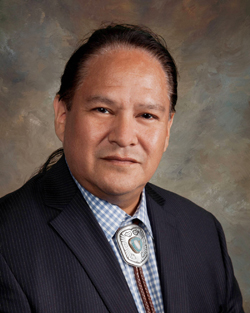By Zachariah Bryan
Northwest Asian Weekly

Chris Stearns, a Navajo Native American lawyer and former two-term chair of the Seattle Human Rights Commission. (Photo courtesy of Chris Stearns)
Now that Seattle has overwhelmingly passed Charter Amendment No. 19, to elect city council members by district rather than at large, what will happen to race representation?
At the moment, city hall has little to offer. City Councilmember Bruce Harrell, who is half Japanese American and half African American, is the only elected person of color in the building.
“There’s 11 elected positions in Seattle — nine council, one mayor, one city attorney — and only one person of color,” said Chris Stearns, a Navajo lawyer who is a former, two-term chair of the Seattle Human Rights Commission. “You do the math.”
But, while Stearns generally supports the idea of district elections and how they can help boost the minority voice, he gets troubled when he looks at the map designed by University of Washington Professor Emeritus of Geography, Richard Morrill. Only one area has a significant minority voice: District 2, in south Seattle.
The district, home to one of the most ethnically diverse zip codes in the nation, 98118, is 77 percent minority, according to data collected by Morrill. The Seattle district with the second highest number of minority people is District 3 in the Capitol Hill/Central District area, with 31 percent. The rest of the districts have percentages in the teens and 20s.
District 2 isn’t just the most diverse, it’s also the poorest and least educated, according to Morrill’s data: It has the lowest median household income ($47,269), the lowest median house value ($370,313), the fewest number of people in managerial or professional jobs (34 percent), the least number of people over 25 with a bachelor of arts degree or higher (29 percent), and the highest poverty rate (20 percent).

Faye Garneau, a North Seattle businesswoman, is singlehandedly responsible for bankrolling the campaign to elect city council members by district. (Photo by Zachariah Bryan/NWAW)
When it comes to the race question, Faye Garneau (who is white) — the North Seattle businesswoman who singlehandedly bankrolled the Seattle Districts Now campaign — was dismissive.
“I’m insulted to be perfectly honest,” she said of allegations that the map could be racist. “There’s only one race and that’s the human race. The color of your skin shouldn’t be reason enough to vote for something.”
She also reasoned that people of color would have a better shot at winning elections since campaigns could be more grassroots — more door knocking and less fundraising. She also pointed to the example of Congressman Adam Smith, a white person who has won in the minority-majority 9th Congressional District.
“People of different skin colors live in all parts of the city, and they can run in any district,” Garneau said.
However, Stearns said that is “out of touch with reality.”
“Running for office as a person of color in a majority white district is just an extremely hard proposition,” Stearns said. “Sure it can be done, but the overall success rate at the local and county levels is pretty low, which also winds up discouraging people to run.”

Seattle’s seven districts
For Morrill’s part, he did consider race at least briefly in making the map. He said he had a choice between having one strong district for minorities, or two somewhat weak districts for minorities with percentages in the 40s.
Stearns said someone familiar with voting rights should look to see if having all of the voting power packed into one district would unintentionally disenfranchise Seattle’s people of color.
“Could the district boundaries be adjusted to more effectively spread out that voting power, but not so much as to dilute that power to the point where it is useless?” Stearns asked. “I don’t know the answer to this, and the answer may very well be that the current map is fine.”
Morrill, who does have experience in voting rights, admitted that the map “could be racist” by having only one district adequately representing people of color. But he agreed with Garneau in that people of color could run in any district.
The map won’t be redrawn until 2020, after the next U.S. Census takes place. According to the charter amendment, a commission would oversee how boundaries could be adjusted. The commission is to be appointed by the mayor and city council. No elected official, lobbyist, candidate, or city employee can be on it.
Until then, Stearns said, people of color need to start figuring out what district elections means for them now.
“Now that the boundaries are drawn, the most important thing is for people of color to familiarize themselves with the boundaries, their own districts, and then come together through their community organizations to figure out how they can maximize their voting power and to support candidates that best represent them,” said Stearns. “Second, voters need to carefully look at the results of the 2015, 2017, and 2019 elections to see if there is a distinct pattern of voter disenfranchisement. If not, great. If so, then the new commission can redraw the boundaries.” (end)
Zachary Bryan can be reached at info@nwasianweekly.com.



